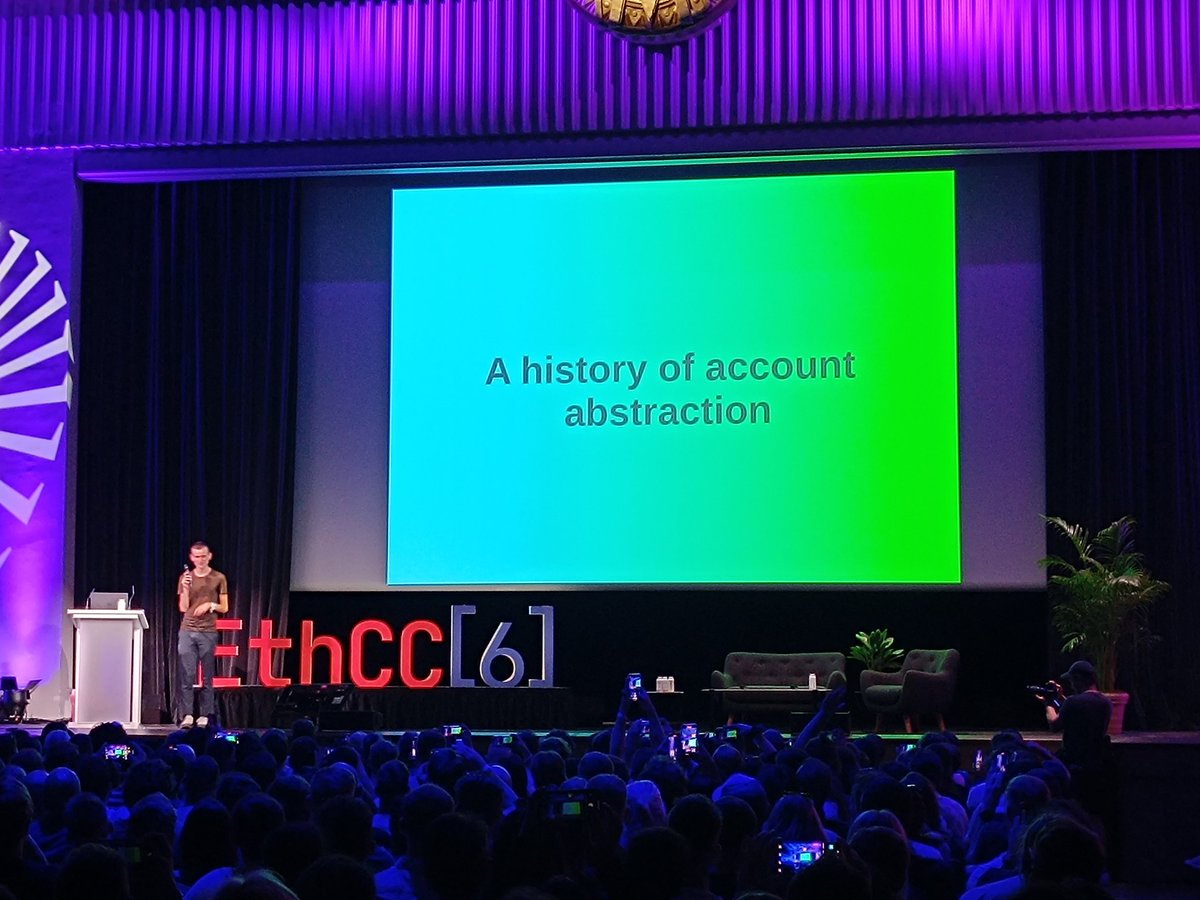Original Compiling: TechFlow Intern

On July 17th, the Ethereum Community Conference (EthCC) officially opened in Paris. Ethereum co-founder Vitalik Buterin delivered a keynote speech endorsing smart contract wallets, focusing on the history and future of account abstraction.
This year, Vitalik has been vocal about his support for account abstraction in smart contract wallets. For example, in a Twitter AMA in June, when asked about his views on wallets based on MPC (EOA) compared to smart contract wallets, he pointed out the fundamental flaw of MPC-based EOA wallets as they cannot revoke keys, making smart contract wallets the only choice.
In Vitalik's view, account abstraction is "very elegant" as it does not require changes to the underlying protocols like previous upgrades.
Account abstraction itself is a rather abstract concept.
Currently, Ethereum accounts are tightly coupled with key pairs to the point where they are essentially the same thing. If you control the private key, you control the account.
Account abstraction decouples the entities (accounts) in the Ethereum Virtual Machine (EVM) from the entities (key pairs or signers) that own movable assets. As long as a CA supports specific functionalities like signature verification, it can be an account.
Account abstraction essentially allows users to define the security model of their accounts, making Ethereum more adaptable for different use cases.
For example, this feature allows users to set their own transaction verification rules, such as multi-signature requirements or spending limits. They can also make their accounts compatible with future cryptographic algorithms.
Vitalik describes account abstraction as allowing Ethereum accounts to be controlled by smart contract code instead of private keys.
His vision is that in the future, people will switch from current EOA wallets to smart contract-based wallets. If successful, managing crypto wallets will become as simple as managing email accounts.
Early Stages of Account Abstraction
Vitalik indicates that the idea of allowing code to control accounts, not just keys, has been present in Ethereum's design from the beginning.
The Ethereum Yellow Paper outlines two types of accounts: externally owned accounts (controlled by private keys) and contract accounts (managed by smart contract code). However, there have been some challenges in implementing account abstraction in its early stages.
In the first proof-of-concept version of Ethereum, it was expected that users would adopt multi-signature wallets more. However, this did not happen immediately, and multi-signature wallets made deposit detection on exchanges more difficult. There were also complexities in paying miner fees from smart contract wallets. The initial vision was for all transactions to be simple "calls," but complications arose due to reasons like non-unique transaction hashes.
Evolution of Account Abstraction
Over the years, the Ethereum community has iterated on several ideas for account abstraction. Suggestions have been made around standardized signatures, the use of "breakpoint" opcodes, and restricting access during transaction verification. However, progress has been slow due to the complexity of changing the underlying protocol and concerns over providing proof of stake. It wasn't until 2020 that a concrete account abstraction EIP (Ethereum Improvement Proposal) was proposed.
Independent projects like the Gas Station Network and Argent Wallet have pushed for further innovation. They have found creative ways to enable meta-transactions and abstract accounts using only smart contracts. However, solutions relying on "wrappers" have drawbacks, such as higher costs per transaction.
Later on, EIP-4337 was proposed, which provides a universal account abstraction standard using only smart contracts, avoiding changes to the underlying protocol.
The Ethereum (ETH) upgrade will allow users to create self-custodial wallets as programmable smart contracts.
This will unlock many features such as easy wallet recovery, signature-less transactions (meaning lower transaction fees), and team wallets (also known as multi-signature wallets).
According to Vitalik, this upgrade could be one of the main catalysts for global Web3 adoption. "One of the key properties we want blockchain to have is giving you money before you even sign up," he said.
He said the idea is to enable users to receive any tokens, such as stablecoins, in their smart contract wallets and be able to pay gas fees without converting their holdings to ETH.
To allow these types of wallets and transactions to be broadcast, the latest account abstraction upgrade will enable "paymasters" that allow users to pay gas fees with any token they are transacting with.
EIP-4337 also includes a signature aggregator that allows multiple signers to join together, with only one being used for the transaction.
Vitalik said, "This is a pretty big deal," especially in Rollups where these types of L2 solutions have limited space for signatures.
Ethereum Layer 2 solutions like Arbitrum or Optimism batch transactions together and validate them off the Ethereum mainnet.
The account abstraction will allow for signature aggregation. In simple terms, this will enable more data compression, resulting in cheaper computations and, according to Vitalik, "an 86-fold reduction in costs".
Furthermore, this is not the only upgrade currently being worked on for Ethereum. Proto-danksharding or EIP-4884 is also in progress. It has quickly become a major focus in network development as it lays the groundwork for a new data type that will significantly reduce costs and make data usage more efficient.
Lastly, Vitalik states that to improve efficiency and censorship resistance, there is increasing interest in directly incorporating partial account abstraction (such as ERC-4337) into the protocol. He also highlights the importance of ensuring smooth transitions for old EOA users and integrating biometric signers, among other innovations.